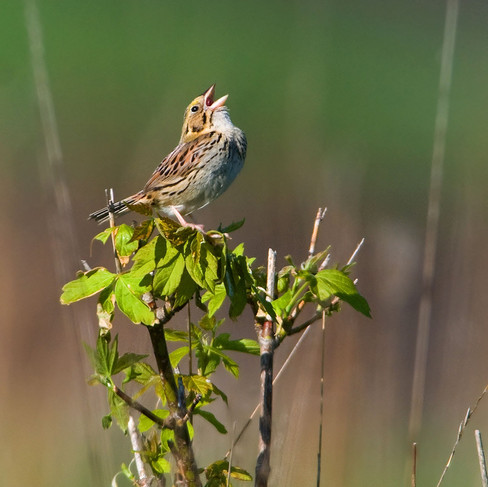The Early Intern Gets the Bird!
- bigoaksfriendsgroup
- Jul 7, 2023
- 4 min read
Updated: Jul 10, 2023
This week we've been monitoring our grasslands for Henslow's Sparrows! Also known by their banding code, HESP!
These surveys take place very early in the day, and have to begin as soon as the sun starts rising. Dawn and dusk are the times when many species of birds are most active, and so if we want to hear them singing, that means that we have to wake up before they do!
To be on time for the dawn chorus, we have to be out in the field and ready to go by 6 am! On the days when we're doing the surveys it can be hard to drag ourselves out of bed that early in the morning, but it's well worth it. Not just for the birds — but also for the gorgeous sunrises!
The way we conduct these surveys is by walking transect lines alongside or straight through the Henslow's grassland habitats. These sparrows prefer habitats with tall grasses (2-4 ft), dense vegetation, and thick litter (<2% bare ground), with few shrubs or trees (<5%). They use these habitats for mating displays during the breeding season, as well as for building their nests and rearing their young.
HESP habitats are managed every few years through a rotating schedule of treatments; including chemical treatment with pesticides, as well as burning. These treatments are done in order to maintain the preferred habitat conditions for the sparrows, primarily by controlling saplings and woody vegetation that invade the grasslands from the nearby forests. Sweetgum and maple trees are the fasts trees to colonize our open grasslands, so our management efforts are mainly focused on keeping those species at bay.
(On the left) A grassland that has been treated in recent years. Few trees and shrubs,
with many sparrows present.
(On the right) A grassland that has not been treated recently. Overrun with maple and
sweetgum trees, with no sparrows present.
To conduct these surveys, all we need are some binoculars, data sheets, and our listening ears! While we walk our transects, we listen for the HESP's distinct song. The Henslow’s Sparrow actually has the simplest and shortest song of any North American songbird! The sound is a buzzed tzelick.
I'm including a link to the song below if you'd like to hear it!
Whenever we hear these songs, we stop walking our transects, and look through our binoculars to see if the bird can be spotted anywhere nearby. They are very secretive however, and are very adept at hiding in and moving through the grasses. Usually, if we're able to see them at all, they're perched on the branches of solitary shrubs doing their mating displays.
I've tried to take pictures of them through my binoculars a few times, but with my shaky hands and my iPhone camera, the pictures are far from professional-grade. But I'm still going to include one here, since I had to try very hard to get it!
(On the left) A high resolution picture of a HESP taken from
the internet (please don't sue me)
(On the right) My best picture of a HESP perched on top of a sweetgum sapling!
When we hear the birds singing, we mark down on our data sheets how far away we heard the bird (according to our best estimate) if we were able to see the bird, and if the bird was dueting with another bird nearby. Only the male HESPs are known to sing, so two birds singing nearby at the same time indicates that they are competing for mates and/or mating territory.

A glimpse of one of our HESP monitoring data sheets!
Whenever we visit these habitats we also make sure to indicate whether or not the field has been recently treated, so that we're able to draw comparisons between HESP success in areas we've actively managed versus in areas that we haven't. We also have to record certain details such as weather conditions, and the amount of time we spent surveying that specific route.
While the precise extents of the impacts of our management efforts on our native HESP populations are still being researched, years worth of data that the refuge has collected over the course of this project indicates strongly that our interventions have been helping to proliferate the species, at least at a local level. Conserving HESP populations is here is critically important, as Indiana is one of the seven states that list Henslow's Sparrow as endangered. Nine other states list it as threatened or a species of special concern.
The reasons for declining populations are due in large part to the loss of their essential breeding habitats. Fire suppression, conversation of pasture to agricultural land, wetland drainage, and urbanization are the main drivers for the destruction of the open grasslands that they need to survive.
Because of this, I feel that our management efforts to maintain these habitats here on the refuge are incredibly important to the conservation of the species, even if HESPs are still being threatened by habitat loss elsewhere throughout their geographic ranges.
Going out to survey these species and to experience them in the wild every few weeks is a genuinely exciting opportunity, and one that I cherish every time I'm invited to help out! (if that doesn't sound too preachy!!) I may not be thrilled to wake up at 5 am every morning, but these birds make it more than worth the occasional sleep deprivation!
Next week, we'll be exchanging our early mornings for late nights as we begin our acoustic surveys for bats! I'm excited for the work, and I'm even more excited to write about it in my next post!
Until next time!
- Maeve










































YAY HENSLOWS